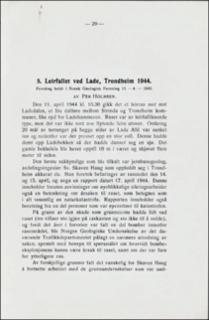Leirfallet ved Lade, Trondheim 1944. Foredrag holdt i Norsk Geologisk Forening 11.4.1945
Journal article

Åpne
Permanent lenke
https://hdl.handle.net/11250/2674573Utgivelsesdato
1946Metadata
Vis full innførselSamlinger
- Artikler [1064]
Sammendrag
On April 11. 1944 a clay-slide took place near Ladehammeren N of Trondheim. About 5 acres of the field between Lade Alle and the Ladebekken streamlet slid down. Liquid clay was not visible. There was great uncertainty about the causes of this slide. On July 23. 1943 a heavy allied bomb raid took place on the German u-boat base \"Nyhavna\", situated a little W of the slide, and a few bombs fell on the area in question. The German military geologists gave the conclusion that bomb explosions caused the clay-slide 8 1\/2 month later. In the opinion of Norwegian geologists, however, among them the author of this paper, the clay-slide was mainly due to natural conditions, some German arrangements, however, having caused \"the initial slide\". During the summer 1944 borings were carried out. Undisturbed clay samples were taken after the method of the Swedish Geotechnical Commission. The author has tried to reconstruct the original stability conditions of the clay deposits, an experiment in which a pre-existing map, scale 1:1 000, has been of great value. The stability calculations resulted in the conclusion above mentioned, which is in good accordance with a de visu witness: the slide began in the lower western part of the area.
